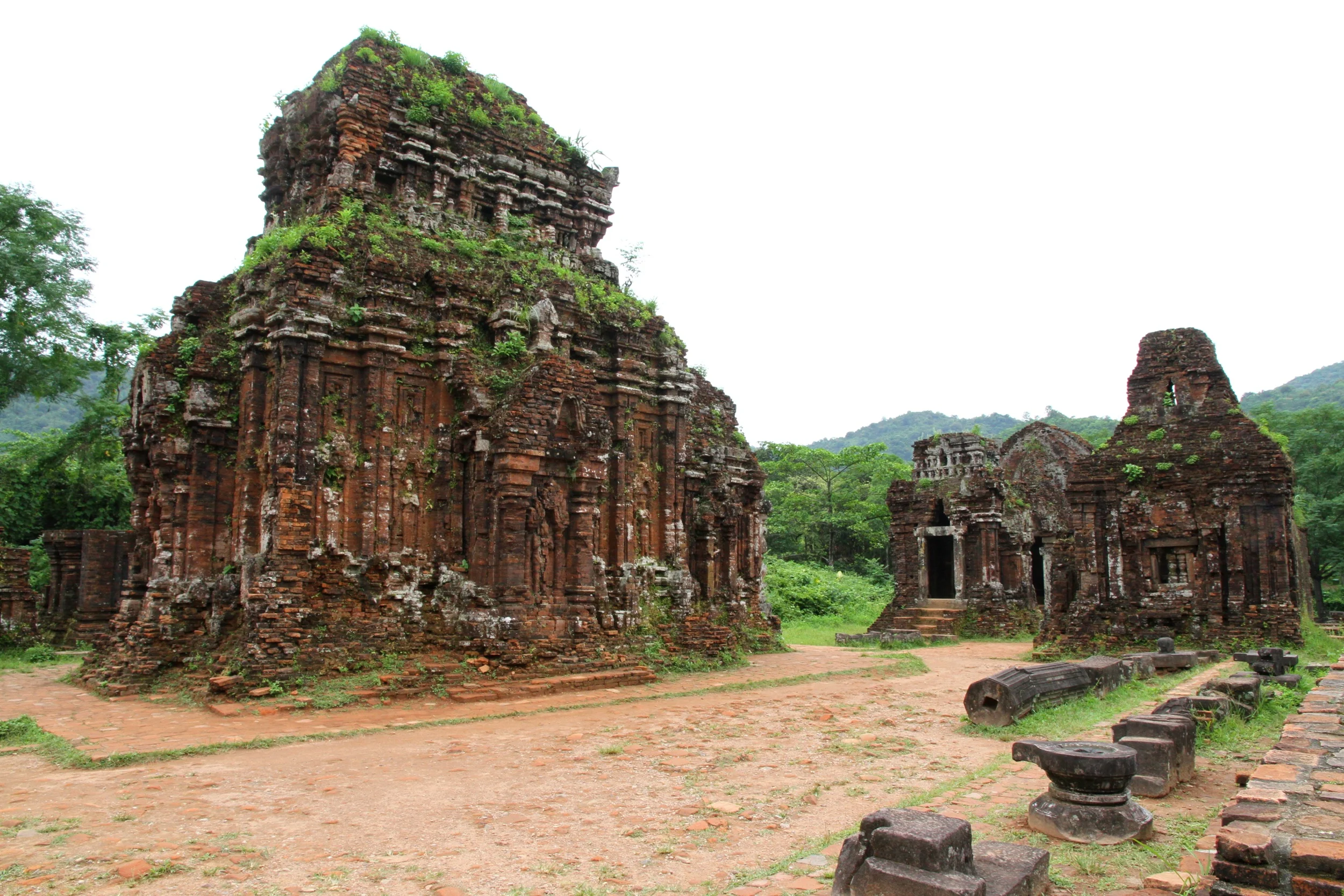Minsk to My Son

I HAD THE PERFECT PICTURE in mind; buzzing out to the Hindu ruins at My Son on an old Russian Minsk - drab army green.
Weaving around water buffaloes. Dodging women selling mangoes in non la (woven conical hats). Smiling children waving grubby little hands and chasing alongside my ride. Warm wind blowing back my hair. I would have been so tough. I would have owned it. Like a tall, American-woman version of Gael Garcia Bernal in The Motorcycle Diaries…
Instead I got a scooter.
Our gang.
What was I thinking? The Minsk is difficult even for experienced riders, and the most practice I’ve had with two wheels and a motor was July 4, 2008, when Jenny B. and I rode mopeds around Tower Grove Park… and I wiped out in the grass.
A scooter makes sense.
We puttered around the garage to prove our competency to our guide at Hoi An Motorbike Adventures, then helmeted up and headed inland toward the ruins.
A stop for coffee, another for lunch, and a handful of sight visits for historical reflection showed us the countryside in a way that wasn’t available by local bus. We took bustling village streets, tight alleys, dirt paths, and even went off-road once or twice, when the straight shot got too complicated.
A quick roadside stop for coffee and conversation.
The journey to My Son was a highlight in itself. Families collecting their rice crop, cow traffic jams, uniformed school kids on bicycles, a decrepit air strip left over from the war, snow-white egrets popping out of neon green rice paddies, lines of chickens crossing the road - gaining two-wheeled confidence with every passing minute meant we could focus on life unfolding around us.
“My Son is as hot as a toaster oven”, said Joe, our guide for the day. He also warned us on the way of the crowds expected. But we were spared both the heat (overcast) and the tourists (perfect timing) - it was just the three of us in a place the Cham built 15 centuries ago to worship Shiva and Vishnu.
The Cham ruins at My Son - a UNESCO World Heritage Site.
ONCE THE HUB of the silk and spice trade in the 7th to 10th centuries, the predominantly Hindu complex also has a Buddhist history dating back to the 9th century. Sadly, nearly every trace of My Son’s Buddhist influence was erased during the war.
In reality, most of the temples were partially to totally destroyed by U.S. carpet bombing in 1969, but My Son is still a sight to behold.
Tucked away in the hills, surrounded by thick, sweltering jungle, parts of My Son are being swallowed by the wild. Some of the ancient structures have begun to look as natural as cliff sides. Further degradation isn’t likely - UNESCO declared the ruins a World Heritage Site in 1999.
ON THE RIDE BACK my mind was still at My Son. Imagining the temples during their prime. How much love, hope, and devotion went into each stone. I saw a Cham soldier, anxious about the imposing Dai Viet from the north, offering gold or flowers to Shiva for guidance.
Then we arrived at the floating bridge… There is nothing like the perception of real danger to suck you out of a daydream.
Swaying with the current, mismatched boards and stalks of bamboo were tied here, nailed there - it hardly looked suitable for foot traffic. But it was our only way home. “It’s a piece of cake”, Joe claimed, “just whatever you do, keep moving”, and rolled right over the rickety flotilla. Grabbing hold of his contagious confidence, I held my breath and hit the throttle, not allowing myself to overthink it.
Safe on the right side, Joe divulged all of the floating bridge fails - and there were a lot of them. He said some are posted on the Hoi An Motorbike Adventures website and thankfully, neither Fernando nor myself will be featured on that page anytime soon. We both rolled across that river like ballpoint pens on a legal pad. Flawless.
In hindsight, maybe I could have handled the Minsk.
VERDICT: Mostly Harmless - as long as you don’t lose your balance.
———-
LINKS:
My Son: Cluster of 20 (remaining) ancient structures built by the Champa Kingdom in Vietnam.
Non La: Conical hat popular in Southeast Asia.
Tower Grove Park: Public park in St. Louis, Missouri, USA.
Hoi An Motorbike Adventures: The largest motorbike tour operator in central Vietnam.
Cham: Ethnic group that populated southern Vietnam from the 2nd to mid 15th century.
Dai Viet: Vietnamese kingdom that had asserted its independence from China in 939.








